Palmer-Moore Company
 | |
| Truck Manufacturing | |
| Industry | Engine and truck manufacturing |
| Genre | Trucks |
| Fate | Competition and lack of capital during World War I |
| Founded | 1906 |
| Founder | Charles L. Palmer, Thomas W. Meachem, T. G. Meachem and Edward Moore |
| Defunct | 1918 |
| Headquarters | Syracuse, New York, United States |
Area served | United States |
Key people | Thomas W. Meachem |
| Products | Water and air-cooled motor and marine engines, trucks |
Number of employees | 600 in 1916 |
The Palmer-Moore Company (1906–1918) was a manufacturer of gasoline and air-cooled motor engines and marine engines in Syracuse, New York. The company began production of commercial trucks beginning in 1912. They were the third manufacturer in the city in the business and specialized in the manufacture of custom designs for local industries.
History
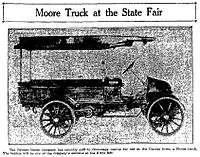
The Palmer-Moore Company was founded in December, 1906 and manufactured motor engines, marine engines and trucks in Syracuse, New York for 12 years until 1918.[1]
The company was founded by Thomas W. Meachem, Charles L. Palmer and Edward Moore, a Franklin (automobile) engineer.[2] Moore was inventor of the engine used in Palmer-Moore trucks and Palmer was secretary and treasurer of the firm.[3] Palmer-Moore was first incorporated in December 1906 and the details were recorded in the Onondaga County Clerks office. The startup had $6,000 in capital.[4]
By 1912, Palmer-Moore Company began the production of trucks with choice of air-cooled or water-cooled engine. The firm specialized in custom designs for local industries such as dairy, oil, delivery and freight trucks.[2]
The company originally called their truck the Moore; however, they were advised by a "concern on the west coast" that another firm had already adopted the name for their truck and had been using it for two years. In February 1914, John H. Valentine of Palmer-Moore Company announced that in the future the company would refer to their truck as the Palmer-Moore because they were asked to change the name as it "caused confusion."[5]
Palmer-Moore was not unlike Chase Motor Truck Company and Sanford-Herbert Motor Truck Company, either in design, or in company background. All three truck companies were founded locally, experienced capitalization problems during World War I and did not survive.[2]
Early production
The company began with production of motor and marine engines in 1906 and manufactured their first motor truck in 1912. The earliest model was 3/4-ton and had a two-stroke engine with throttle control.[3]
A 1,500-pound (680 kg) delivery wagon was in the works for 1913. The company planned on hiring 150 employees and according to management "200 trucks will be put out the first six months of 1913."[6]
The Palmer-Moore plant was located on Geddes Street at Erie Boulevard in Syracuse. It was described as "little more than an assembly line employing 100 men" when it reached its production peak of close to 600 trucks in 1916.[2]
Motor and marine engines

By August 1911, Palmer-Moore had spent several years and considerable money perfecting a novel two-cycle engine invented by Edward Moore, who was owner of the basic patents.[7]
The company had several engineers who were enthusiastic about their new engine. The speed and power engine control "is gained by shifting the effective length of the ports and the engine can be changed instantly from low to high speed which does away with much gear shifting."[7]
Company officers
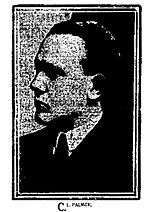

The company was founded by Thomas W. Meachem, son of the founder of New Process Gear Company, Thomas G. Meachem and Charles L. Palmer, a Syracuse University student whose father was A. W. Palmer, a trustee of the Onondaga Savings Bank and Edward Moore, a Franklin (automobile) engineer.[2] Charles L. Palmer was secretary and treasurer of the company from the earliest days.[3]
Charles L. Palmer was still the acting secretary by December 22, 1909 when the annual stockholders meeting was announced for January 11, 1910 at the company headquarters on Tallman Street.[8]
T. G. Meacham was elected president of the Palmer-Moore Company and T. W. Meachem was chosen for vice-president at a meeting of the board of directors on August 15, 1911 at the company headquarters on Tallman Street. The capital stock of the company had been increased from $25,000 to $100,000 and the election of new officers and his son of New Process Rawhide Company had acquired a controlling interest in the company.[7]
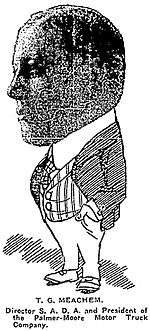
It was stated that all the capital stock had been subscribed. Charles L. Palmer was secretary and treasurer and the board of directors consisted of T. W. Meachem, T. G. Meachem, Charles L. Palmer, A. M. Palmer and Edward Moore. The management was planning to install new machinery and expanding the business.[7]
The board of directors met on November 4, 1911 and increased the number of directors from five to seven members. The newly appointed directors were J. N. Willys of Willys Overland Company of Toledo, Ohio and J. F. S. Meachem. It was announced after the meeting that the company would build the new plant and that the "present annual output" of 500 engines a year would be increased "many times" and "this will mean the employment of a larger force of men." The officers of the company included T. G. Meachem, president; T. W. Meachem, vice-president and C. L. Palmer, secretary and treasurer. In addition, J. N. Willys, A. M. Palmer, Edward Moore and J. F. S. Meachem constituted the board of directors.[9]
Willys-Overland
During November 1911, J. N. Willys of Toledo, Ohio, president and owner of the Willys-Overland Company, which produced approximately 25,000 motor cars a year, had taken a large block of stock in the Palmer-Moore Company and had been added to the directorate of the company. At that time, Palmer-Moore planned to build a new plant in Syracuse in the spring of 1912 and "will increase its capacity many fold." Willys wanted to use the Palmer-Moore engines in the Overland Automobile trucks and pleasure cars.[9]
Truck production
During 1913 Palmer-Moore was producing a truck with 1.5-ton capacity, three-cylinder air-cooled engine. The truck also came with a water-cooled engine which the company bought, along with the wheels, gears and transmission from other companies.[2] The 1913 model was priced at $1,425 and the company touted that it exceled for light delivery work. It had solid tires which were guaranteed for 8,000 miles (13,000 km) and were advertised to save the car owner "at least 6 cents per mile over pneumatic tires."[10]
| “ | No joy riding. Enough speed for all useful purposes, but no more. 1913 advertisement[10] | ” |
The 1913 air-cooled model also had "simple lubrication" which required one quart of oil be poured in the tank for every five gallons of gasoline. The engine was valveless and had "no jiggers to adjust and no seats to grind."[10]
The 1914 models had "new" rear spring construction which "gives pneumatic tire riding qualities without pneumatic tire expense." The trucks included:[11]
|
|

Model years
The fastest selling model in 1915 was a new one-ton motor truck "which has stood the test of jitney (taxi) service and advanced the company's rating as a vehicle for carrying cars." A 3/4-ton model was produced by the company for the previous three years and was still in demand. The new one-ton truck looked almost identical to the smaller model and had the same features of "simplicity, economy and efficiency." The truck construction was heavier and larger and was designed to meet the demand for a medium capacity truck where great strength and room are desired without any great increase in expenditure for gasoline and upkeep.[12]
By 1916, the company offered the Model K for $1,150 with a capacity of 1,500 pounds (680 kg) and the Model M for $1,350 with a capacity of 2,000 pounds (910 kg). Both trucks had four-cylinder engines with Bosch ignitions and disc clutches.[13] The two-ton model included the same standard parts as the one-ton model. The motor, springs, tires, frame and clutch were larger and the wheelbase considerably longer. Loading space in the truck was 11 feet (3.4 m) by 56-inch (1,400 mm). As with the one-ton models, the new truck came in several body styles including open express, stake, four-post, full panel standard bodies and open express with full panel top. Additionally, "extra long or wide" bodies could be "furnished to order." That same year, Palmer-Moore also manufactured a 3/4-ton truck as well as motor busses and jitneys.[14]

Company facilities
In 1906, the company headquarters were located in the Wieting Block in downtown Syracuse. They relocated next to 311–319 East Washington Street, however, moved from the 4,000 square feet (370 m2), second floor location by November 1909.[2] Company headquarters by December 22, 1909 were located at 230 Tallman Street.[8]
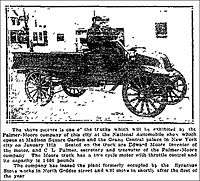
By November 24, 1912 the company plant at the corner of Tallman of Oneida streets, "suitable for a repair shop or light manufacturing," was on the market as a rental. Palmer-Moore still occupied the building.[15]
During December 1912, the company bought a large plant formerly owned by Syracuse Stove Company at 100 North Geddes Street where they manufactured motor trucks. T. W. Meachem bid $20,000 at a bankrupt sale. The property was appraised for $75,000[6] and described as "several substantial brick buildings, two which are equipped with elevators."[1] The total size of the property was 4 acres (16,000 m2). On the Geddes Street side of the plant the general offices, a large display room, sales department and drafting room were located.[16]
The land itself had frontage 365 feet (111 m) by 303 feet (92 m). A New York Central Railroad switch adjoined the property in the rear. The buildings contained more than 80,000 square feet (7,400 m2). Palmer-Moore stayed in that location until the company closed in 1918.[1]
Auto shows
A Palmer-Moore truck was exhibited at the National Automobile Show in New York City which was held at Madison Square Garden and the Grand Central Palace and began on January 11, 1913.[3]
The 1914 National Automobile Show was not open to commercial trucks; however, Palmer-Moore Company "engaged" a store at 48th Street and Lexington Avenue in Manhattan to show their air-cooled chassis. Employees who attended the show included, John H. Valentine and Frederick H. Plumb, who was "in charge."[17]
That year, the New York Auto Show Week began on January 3, 1914. Palmer-Moore Company had two trucks on display. The first was an air-cooled chassis and the second was an air-cooled or water-cooled open express truck with a detachable top. Both trucks had a capacity of 1,600 pounds (730 kg).[3] One of the trucks had a panel top, a water-cooled open express body and a four-post style bed.[17]
Two of the latest models were also "on the streets" for demonstration purposes. The company advertised the latest models as "the snappiest looking, quietest running and sturdiest built light delivery truck on the market."[3]
In February 1914, T. G. Meachem represented the Palmer-Moore Company at the Chicago Automobile Show.[18]
Sales agencies
Frederick H. Plumb of the Palmer-Moore Company began a unique trip across the State of Iowa in one of the company's trucks. He went to Dubuque, Iowa by train, shipping one of the Moore trucks to that point and began his trip from that city across the state in the truck for the purpose of establishing agencies. Plumb did not know anything about the condition of the roads in that part of the country but did not anticipate any trouble.[19]
| “ | With hay and oats and horseflesh going up in price there is more changing in motor trucks than ever before. People are being convinced that the truck is the only thing for them to use, including merchants of all kinds, stock raisers and the like. A few years ago people bought trucks for the novelty of the thing. Now, however, people are being educated to the value of trucks. Robert M. Barker, advertising manager[20] | ” |
By November 1913, Palmer-Moore Company had established sales agencies in various cities around New York State including Binghamton, Utica, Auburn, Hudson and Rochester. The company also had an agency in Providence, Rhode Island. Sales manager, J. W. McCrea, traveled to the Midwest to solicit agencies in several large cities such as Cleveland, Ohio and Minneapolis, Minnesota.[21]
Robert M. Barker was hired as advertising manager in October 1913. He had previously work for two years at Chase Motor Truck Company as advertising manager and previously in New York City at Collin Armstrong in the advertising agency business for more than six years.[22]
Barker was still advertising manager at Palmer-Moore Truck Company in February, 1916 and touted that the company "considered the outlook better at the present time than it has ever been and that judging from inquiries received and the actual sales already made this year, our spring business will be the biggest it has ever been."[20]
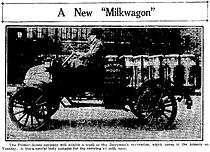
Specialty trucks
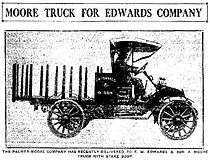
Palmer-Moore was a favorite with local businessmen because they would customize their trucks to match the industry. As early as 1912, the company was building specialty trucks for enterprises like an ice cream company in Providence, Rhode Island. By late 1912, Palmer-Moore reported a considerable increase in local business. Among one of the orders that season was the Haberle-Crystal Spring Brewing Company which had just bought a four-post type for the purpose of carrying 80 cases of bottled beer.[23]
During June 1913, the company built special bodied trucks for C. E. Mills Oil Company of Syracuse. One carried a tank with a capacity of 230 US gallons (870 L) and the other was a stake wagon suitable for all purposes.[24]
Later that year in October 1913, E. W. Edwards & Son department store purchased a Palmer-Moore stake truck[24]
By November, the Monroe County Oil Company of Rochester, New York ordered an open express model with 1,600 pounds (730 kg) capacity. The truck had a specially constructed body, having extra width and very low sides to facilitate the handling of oil cans. The body was painted green, with lettering in gold and yellow running gear.[21]

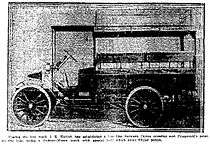
In January 1914, the company sold a four-post express truck to J. & F. B. Garrett Company of West Fayette Street. The truck was finished in light green with yellow running gear and gold lettering. It was to be used for hauling paper from freight houses and for delivery to various printing establishments.[25]
Some of the other enterprises that had Palmer-Moore trucks by August 30, 1914 were New Process Gear Company, manufacturers of gears; C. E. & H. P. Clark Company, supplies; A. L. Lockwood, ice cream and baked goods, W. J. Scheidelman, dairy and produce, and Saratoga Vichy Springs Company in Saratoga, New York, producers of bottled water.[26]
Additionally, Jesse Heath of Binghamton, New York for carrying U.S. mail and Arthur Banfill, grocer from Albany, New York, Heath & Kinney, grocers of Amber, New York and Garrett Coal and Ice Company of Auburn, New York.[26]
J. E. Horton of Syracuse was using the jitney introduced in 1915 as an 18-passenger bus between the "interurban" and the resorts on Otisco Lake. The truck was custom designed with an "unusually high body" for use in carrying furniture "after the summer season closes." Before he purchased the new truck, Horton operated a 14-passenger Palmer-Moore truck and later converted it to a general delivery wagon.[12]
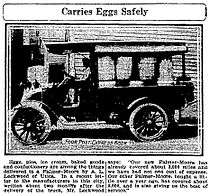
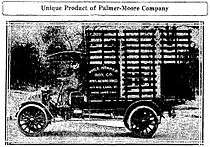
During September 1915, Palmer-Moore announced they had sold a "special panel stake truck" to Cloverland Dairy Company for use carrying 30 US gallons (110 L) of milk "principally for long hauls."[23]
In February 1916, Palmer-Moore trucks were driven by Edward Joy Company, grocers; Thomas Ryan's Consumers Brewing Company; Hurwitz Bros. Inc.; Hackett Hardware Company of Ogdensburg, New York; Syracuse Supply Company and C. W. Snow & Company.[27]
The city of Syracuse, Department of Public Works, purchased three 1916 Palmer-Moore trucks for special work.[12] Additionally, several local enterprises including plumbers, manufacturers, merchants, stock raisers, truck gardeners, fruit growers, bottlers, truckmen, dairymen, dry good stores, box manufacturers as well as hardware and furniture dealers also drove the trucks.[14]
The company advertised that "strong features that make for Palmer-Moore popularity and repeat orders are the Buda four-cycle motor, an internal gear drive rear axle and Palmer's own distinctive rear spring construction."[14]
By October 1916, one of the most unusual motor trucks seen on the city streets was the Palmer-Moore one-ton "special crate body" truck designed for Uhle & Kramer of 415-416 Canal Street, manufacturers of wooden boxes.
The body of the Uhle & Kramer truck contained 300 cubic feet (8,500 L) of space "affording plenty of room for the large and bulky loads carried" and the platform of the truck measured 10 feet (3.0 m) by 58-inch (1,500 mm).[14] The "crate sides" and front extended to a height of 6 feet (1.8 m) above the platform and the truck had a 3 feet (0.91 m) crate tail gate. The vehicle was painted a bright red with black striping and gold lettering.[14]
Later years
On November 5, 1916 the company announced their new two-ton model and advertised in the local newspaper.[28]
The company increased its capital stock from $200,000 to $300,000 in November 1916. The additional capital was to be used for expansion "which will make possible an output five times the present production." The company was also planning on hiring another 200 employees. A one-story factory 195 feet (59 m) by 80 feet (24 m) behind the main plant on North Geddes Street was under preparation for expansion purposes and was to be used for assembling chassis.[29]
The increased output would mean from 700 to 800 trucks would be produced in 1918. The "financial scheme" called for the issuance of 1,000 shares of preferred stock at $100 each, making the additional $100,000 capitalization possible. The preferred stock would be retired on thirty days notice. The remainder of the shares was common stock. The certificate of increase was filed with the Onondaga County Clerk Whitney. The action was taken by the board of directors with T. G. Meachem presiding as chairman with C. L. Palmer as secretary-treasurer.[29]
Company fails
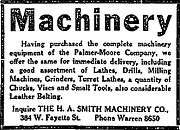
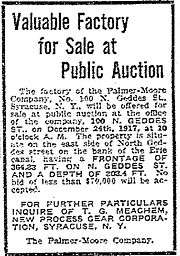
Like Chase Motor Truck Company and Sanford-Herbert Motor Truck Company, Palmer-Moore Company succumbed to the opposition of well-financed manufacturers in other cities who had already mastered the trend of "buying ever less and making even more of the parts for their machine."[2]
On March 5, 1917, Palmer-Moore stockholders voted to discontinue business. It was hoped that arrangements could be made with Eagle Wagon Works of Auburn, New York, however, the "proposition did not work out satisfactorily."[30]
By April 1, 1917, the machinery and tools were purchased by H. A. Smith Manufacturing Company who put them on the market as a "good assortment" of lathes, drills, milling machines, grinders, turret lathes, chucks, vises and small tools and leather belting for "immediate delivery."[31]
The plant on North Geddes Street was placed up for sale at public auction by December 18, 1917. T. G. Meachem of New Process Gear Corp., former president of the company, was point of contact.[32]
The plant was purchased by B. Lyman Smith, president of the Smith Wheel Company in March 1918 from Thomas W. Meachem, former president and cofounder of Palmer-Moore Company. Smith used the facilities to expand his wheel business. According to reports circulated in business circles, the property was sold for $50,000.[1]
The complex has since been replaced with a gas station which is situated on the northeast corner of North Geddes Street and Eire Boulevard, a busy commercial intersection in Syracuse.
Advertisements
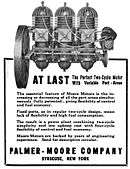 Palmer-Moore, "Moore Motors" - Power Wagons, June, 1912 |
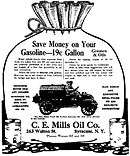 C. E. Mills Oil Company Advertisement and their new Palmer-Moore truck in June, 1913 - Syracuse Herald, June 22, 1913 |
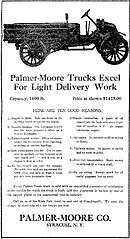 Palmer-Moore Company - Advertisement 1913 - "Low maintenance expense. Can be operated by anybody having ordinary eyes, ears, hands and feet, and is easy as a wagon to keep in order" - Syracuse Herald, September 7, 1913 |
 Palmer-Moore Company - 1913 "Dairymen, Milk Dealers and Ice Cream Manufacturers - Syracuse Herald, December 7, 1914 |
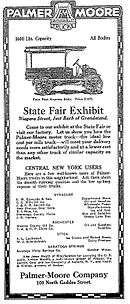 Palmer-Moore Company Advertisement - State Fair Exhibit - Syracuse Herald, August 30, 1914 |
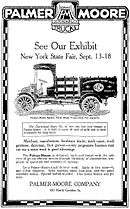 Palmer-Moore Company Advertisement - "Cloverleaf Dairy" - Syracuse Herald, September 12, 1915 |
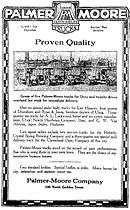 Palmer-Moore Company - Group of five Palmer-Moore trucks for Utica, New York - Syracuse Herald, April 9, 1916 |
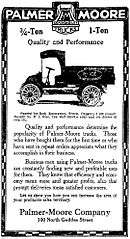 Palmer-Moore Company Advertisement - "Special Ice Body Emergency Truck" - Syracuse Herald, July 23, 1916 |
 Palmer-Moore Company Advertisement "Open Express Body" - Syracuse Herald, October 29, 1916 |
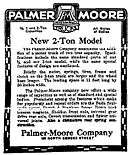 Palmer-Moore Company Advertisement "New two-ton model" - Syracuse Herald, November 5, 1916 |
References
- 1 2 3 4 "Palmer-Moore Plant Sold to B. L. Smith". Syracuse Herald. Syracuse, New York. March 30, 1918.
- 1 2 3 4 5 6 7 8 "For Rent". Syracuse Herald. Syracuse, New York. May 13, 1909.
- 1 2 3 4 5 6 "Moore Truck to be Exhibited in this City". Syracuse Herald. Syracuse, New York. December 29, 1912.
- ↑ "New Companies". Syracuse Herald. Syracuse, New York. December 31, 1906.
- ↑ "Seen and Heard at the Auto Show". Syracuse Herald. Syracuse, New York. February 27, 1914.
- 1 2 Automotive Industries, Volume 27. The Automobile Weekly, The Class Journal Company, New York. N.Y., December, 1912. Retrieved September 13, 2010.
- 1 2 3 4 "Meachem at Head". Syracuse Herald. Syracuse, New York. August 15, 1911.
- 1 2 "The Annual Meeting of the Stockholders". The Post-Standard. Syracuse, New York. December 22, 1909.
- 1 2 "Willys a Director". Syracuse Herald. Syracuse, New York. November 5, 1911.
- 1 2 3 "Palmer-Moore Trucks Excel For Light Delivery Work". Syracuse Herald. Syracuse, New York. September 7, 1913.
- ↑ "Palmer-Moore". Syracuse Herald. Syracuse, New York. September 10, 1916.
- 1 2 3 "Palmer-Moore Company Has New Jitney Truck". Syracuse Herald. Syracuse, New York. July 12, 1915.
- ↑ The Horseless age: the automobile trade magazine, Volume 37. E. P. Ingersoll, New York, New York, 1916. Retrieved September 13, 2010.
- 1 2 3 4 5 "Palmer-Moore to Make a Two-ton Motor Truck". Syracuse Herald. Syracuse, New York. October 29, 1916.
- ↑ "To Rent: Business Places". Syracuse Herald. Syracuse, New York. November 24, 1912.
- ↑ "Announces New One Ton Model". Syracuse Herald. Syracuse, New York. February 21, 1915.
- 1 2 "Many Going to Big Automobile Show". Syracuse Herald. Syracuse, New York. December 28, 1913.
- ↑ "Syracusans Find Chicago Show of Great Interest". Syracuse Herald. Syracuse, New York. February 8, 1914.
- ↑ "To Cross Iowa in Moore Motor Truck". Syracuse Herald. Syracuse, New York. May 25, 1913.
- 1 2 "This Year Will Be Greatest in Truck History". Syracuse Herald. Syracuse, New York. February 20, 1916.
- 1 2 "Sell Special Truck". Syracuse Herald. Syracuse, New York. November 2, 1913.
- ↑ "Robert Barker Joins Palmer-Moore Firm". Atlanta Constitution. Atlanta, Georgia. October 19, 1913.
- 1 2 "See Our Exhibit - New York State Fair". Syracuse Herald. Syracuse, New York. September 12, 1915.
- 1 2 "The Motor World". Syracuse Herald. Syracuse, New York. June 18, 1913.
- ↑ "The Auto World". Syracuse Herald. Syracuse, New York. January 4, 1914.
- 1 2 "State Fair Exhibit". Syracuse Herald. Syracuse, New York. August 30, 1914.
- ↑ "Service that Satisfies". Syracuse Herald. Syracuse, New York. February 20, 1916.
- ↑ "Palmer-Moore New Two-Ton Model". Syracuse Herald. Syracuse, New York. November 5, 1916.
- 1 2 "Palmer-Moore Increases Capital Stock $100,000". Syracuse Herald. Syracuse, New York. November 9, 1916.
- ↑ "May Desolve Company". Syracuse Herald. Syracuse, New York. March 5, 1917.
- ↑ "Machinery". Syracuse Herald. Syracuse, New York. April 1, 1917.
- ↑ "Valuable Factory For Sale at Public Auction". Syracuse Journal. Syracuse, New York. December 18, 1917.
| Wikimedia Commons has media related to Palmer-moore vehicles. |